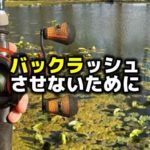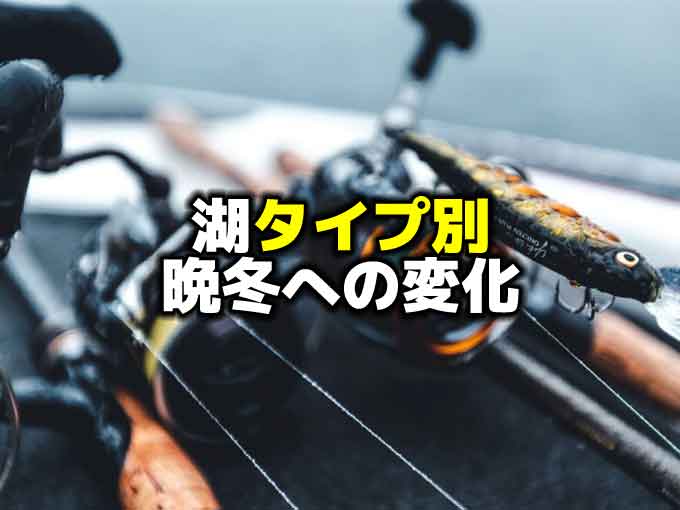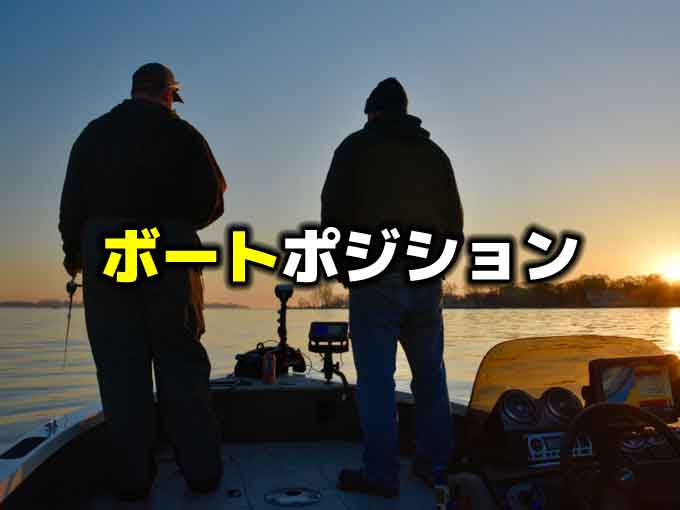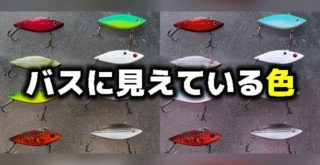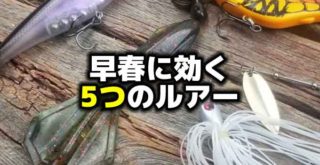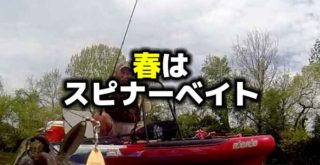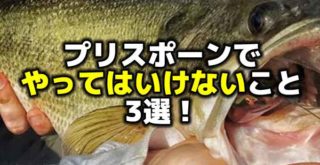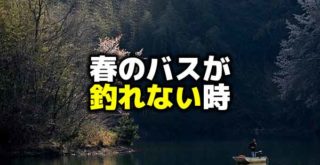冬のオカッパリバス釣り:4つの戦術

Photo by wired2fish.com
こんにちは!店長の小山です!
本日は海外サイトより、”4 Bank Fishing Tactics for Cold Weather”と言う記事を引用してご紹介いたします。
引用先:wired2fish.com ”4 Bank Fishing Tactics for Cold Weather”By Walker Smith •Dec 18/2018(海外サイトです)
オカッパリには厳しい季節、そうですね、個人的な印象では10月くらいからでしょうか、段々とバスが岸から離れてしまう感じで、釣りづらくなる感じがしています。
冬になるとそれはもう決定的に厳しく、岸からルアーが届く範囲にバスが来るのは1日の中でもほんの短い時間だけ、という感じです。イメージ的には。
長く通っているフィールドですと、冬はここにフィーディングに来る、なんていう場所が分かってきて、1日そこで粘るようなこともできるのですが、それでもなかなか厳しいもので、3日間で1バイトみたいなこともあると思います。
しかしそんな風に同じフィールドにずっと通っていって、冬のヒントを見つけ出す方と言うのは、とても観察眼に優れていたり、物事を順序立てて組み立てることができて、そして食わせる力もある、上級者の方が多いような気がします。
裏を返せば、上級者の方であっても冬のヒントを見つけ出すには苦労をするということでもあります。
できれば、そういう風にして学んだことを私たちに共有していただければな、と思うのですが…。
この記事は、アメリカのバスフィッシング専門メディア「Wired 2 Fish」の記事で、トーナメンターとしての側面も持つ記者のウォーカー・スミス氏が、これまでに学んできた冬のオカッパリフィッシングでの戦術を4つ、共有してくれています。
一体どんなことが書かれているのか、ちょっと読んでいきましょう。
この時期、風は友達ではない
This is one of the things that threw me off the most while trying to catch 'em in cold water. For years, I had always heard about fishing the windy sides of ponds. It was drilled into my head growing up, so I figured there had to be something to it.
False. The wind is not your friend this time of year.
The windblown banks of a pond will often be four to five degrees cooler than the calmer side. Every fish in the pond (bass, bluegill, crappie, shad, etc.) wants to be in the warmest water it can possibly be in. A few degrees may not sound like much to a human, but it can completely change the demeanor and feeding behavior of bass. In the winter, calmer water is warmer water. And the warmer the water, the higher your chances are of catching big bass.
While it does reduce the amount of fishable water, I believe your time will be best spent methodically dissecting the higher percentage calm water. If you’re unable to escape the wind, hope isn’t entirely lost. You can still catch a couple, but it’ll be tougher. In these situations when you’re forced to deal with the wind, I’d suggest a spinnerbait. I don’t know exactly why, but it seems to work best in my experience.
これは低水温期の釣りをしようとしている私を一番に裏切ってくれたことのひとつです。何年もの間、私はいつも池では風の強い側を釣れと言われてきました。私がちょうど成長しているときに頭に焼き付けられたものなので、私はそれがもう当然なのだと思っていました。
やられました。この時期、風はあなたの友人ではありません。
この時期、池の風下側の水温は、穏やかな側よりも2~3℃低いはずです。池の中のすべての魚(バス、ブルーギル、クラッピー、シャッドなど)は、一番暖かいところにいたいと考えます。その数℃は人間にとっては大したことのない数字に聞こえるかもしれませんが、バスの振る舞いやフィーディング活動を完全に変えることができます。冬においては、穏やかな水が暖かい水です。水が暖かいほど、ビッグバスをキャッチする可能性は高くなります。
釣りができる可能性のあるエリアは減ってしまいますが、穏やかなエリアを探っていくことでより確率の高い時間を過ごすことができると私は信じています。風から逃れることができない状況でも、完全に希望が失われるわけではありません。状況はかなりタフですが、2、3本はキャッチすることができるかもしれません。どうしても風に対抗しなければならない状況のとき、私はスピナーベイトをおすすめします。正確な理由は私にもわからないのですが、私の経験上では一番うまくいっています。
晴れた日を活用する
We all have busy schedules, so we’re not able to fish whenever we please. As you’re making your fishing plans for the week or weekend, make absolutely certain to check the forecast first. If the sun will be shining, try to hit the pond for a few hours. This can be one of the best times to catch your personal-best bass. That’s no exaggeration.
By now, the female bass have already started developing eggs. Additionally, they’ve been feeding up for the winter and burning very few calories due to their lethargic behavior. All of this results in fat bellies and big bass.
On these sunny days, these big females will often move higher into the water column to soak up the much needed warmth of the sunlight. I liken it to human behavior: It sucks being stuck inside when it’s cold and dreary during the winter. When that sun finally comes out, though, what do we do? We go outside and take advantage of it. It makes us more active and puts us in a better frame of mind. The same thing happens with bass.
If the pond you’re fishing is particularly muddy, your chances are even higher of catching big bass. Because dirty water is denser than clear water, the shallows will warm up much quicker during these seemingly brief periods of sunlight.
So based on we’ve discussed so far, I’d absolutely recommend trying to focus your fishing efforts on calm, sunny days if at all possible.
私たちは皆忙しいスケジュールをこなしていますので、いつでも釣りに行けるわけではありません。平日でも週末でも、釣行計画があるのであれば、まずは天気予報から確実にチェックしてください。太陽マークが輝いている場合は、数時間は池で投げまくるようにしてください。これはあなたの自己最高バスをキャッチする最高のタイミングの1つになります。これは決して言い過ぎではありません。
このころは、メスのバスはすでに卵を抱え始めています。さらに彼らは無気力で、カロリーを消費しない上にフィーディングをしています。このすべてが、ビッグバスの腹をさらに太くさせます。
これら晴れた日になると、大きなメスのバスは表層の方へと移動し、必要とする日光の暖かさを吸収します。これを人間の行動に例えると、こうなります:冬の間の寒く荒れているようなときには、家の中に閉じこもりがちになってしまいます。やがて太陽が出てきたとき、私たちはどうするでしょう?外に出て日に当たろうとします。それは私たちをより活発にし、私たちをより前向きにしてくれます。バスにも同じことが起こるのです。
釣りをしている池が特にマッディ系であれば、よりビッグバスが釣れる確率は上がるでしょう。濁った水は透明な水よりも密度が高いので、一見すると短時間だけ太陽が出たくらいでも、シャロー側はかなり早く暖まるはずです。
というわけで、ここまで解説してきたことを踏まえ、穏やかで晴れた日に集中して釣ろうとするのは絶対にお勧めです。
スローダウン
It’s difficult to fish slowly from the bank at times. I think that’s because we’re standing-not sitting-and we’re constantly looking for new areas and we can walk wherever we please. It’s imperative, however, to slow down this time of year. If you think you’re fishing slowly, slow down even more. It’s irritating at times, but it’s worth it.
As you could probably imagine, bass aren’t chomping at the bit to feed in cold weather. Of course they’ll still eat, but their feeding windows-and their strike zones-become much smaller. They’re probably not going to chase down a fast-moving lure to attack it.
I prefer a Texas rig this time of year, as it allows me to keep the bait in a small area for an extended period of time. It’s important to note, however, that I’ll actually use a heavier weight than normal. Instead of using a 1/8-ounce Texas rig, I’ll usually step up to a 1/4-ounce weight.
I do this in order to create temporary snags, as dumb as that sounds. If I’m fishing a laydown or a brush pile, that heavier weight is more prone to snag the cover for a second or two. While it’s snagged, I’ll lightly shake my rod tip for a few seconds while keeping the Texas rig in place.
More times than not, that big bass will eat your bait while it’s snagged like that. You won’t always feel a thump, either. You’ll often feel it get heavier and your rod tip will slowly be pulled down. Don’t hesitate to set the hook quickly; if you’re slow to react, you might give the fish time to wrap you around the cover.
往々にして岸釣りはスローな釣りをしてしまうと魚を釣ることが困難になります。私たちはそこに座ってしまうことなく立ち続け、常に新しいエリアを探し、どこまでも歩いていくべきなのです。しかし、この時期においてはスローダウンは不可欠です。自分でスローに釣っていると思うところから、さらにスローダウンしてください。それはイライラしてしまうかもしれませんが、それだけの価値があります。
みなさんが思うように、寒い季節にはバスはムシャムシャ食べていて活発にバイトしてくるわけではありません。もちろん、フィーディングはしているでしょうが、彼らのフィーディングスイッチやストライクゾーンはかなり小さくなります。彼らはおそらく、ファーストムービングルアーを攻撃しようと追いかける気にはならないでしょう。
私はテキサスリグをこの時期に好んでいます。なぜなら、これは長い時間、小さなエリアにルアーを置くことができるからです。しかし、実は普段より重いシンカーを使用していることに注意することが重要です。 普段1/8オンスのテキサスリグを使用するところで、1/4オンスのシンカーにステップアップします。
これは一時的な根掛かり状態を作るために行います。もしレイダウンやオダを釣っているなら、シンカーが重いほど、カバーにはすぐに根掛かりしやすくなります。うまく引っ掛かったら、テキサスリグをその場に留めつつ、ロッドティップを数秒間軽くシェイクします。
ほどなくして、その引っ掛かった状態のルアーをビッグバスは口にします。しかしいつものような強いバイトが出るとは限りません。ただ重くなって、ロッドティップがゆっくりと引っ張られる程度と感じるかもしれません。このとき、素早いフッキングをためらわないでください。反応が遅い場合は、魚に周りのカバーに巻かれてしまう時間を与えてしまうかもしれません。
ヨーヨーのごとく釣る
This is something I’ve had a bunch of success with lately. Instead of casting next to a stick, log or any piece of wood cover, try casting over it. I know that kind of goes against what you might think, but it produces a lot of extra bites from those cold, lethargic bass.
This approach allows you to “yo-yo" your bait over the branch and keep it stationary, all while moving it vertically and keeping it in a high-percentage strike zone. Many times in cold water, bass will snug up to a piece of cover as close as they possibly can. When they do this, their strike zone may be less than a foot-wide radius.
Yo-yoing your bait is simple. Instead of bringing it over the limb, bring your weight to the top of the limb. Drop your rod tip and allow your bait to fall to the bottom. Repeat the process several times and be sure to keep a good eye on your line. As your bait falls to the bottom, a bite is often indicated by an abrupt jump in your line. When you see this, it’s time to set the hook.
While winter fishing can flat-out stink at times, these are the factors we can control. If you try to fish during the right weather conditions and present your bait correctly, you’ll have a great chance of curing the winter blues and catching some really big fish.
これは最近で私が一番の成功を収めたものです。小枝、丸太、その他のウッドカバーの横へキャストする代わりに、それらを飛び越えてキャストしてみてください。みなさんが思っていることに反していることは分かっていますが、寒くて無気力になったバスからより多くのバイトを誘います。
このヨーヨーアプローチは、ストライクゾーンの可能性が高いと思われるところで枝にルアーを引っ掛け、タテに動かして止めたり、そこに置いておくことができます。低水温下では、バスはきるだけカバーにぴったり寄り添うようになります。こうなってしまうと、彼らのストライクゾーンは半径30センチより小さくなってしまうかもしれません。
ヨーヨーイングはシンプルです。枝を乗り越えるのではなく、シンカーを枝のところまで持ってきたら、ロッドティップを下げ、ルアーをボトムまで落とします。これを何度も繰り返し、このときはラインを良く見ていてください。ルアーがボトムに落ちたとき、ラインが突然ジャンプしたようになったらそれがバイトです。これが確認できたらフッキングする時です。
冬の釣りは時にはひどい失敗に終わるつこともありますが、それは私たちがコントロールできる要因です。適切な気象条件で釣りをして、ルアーを正しくプレゼンテーションできれば、冬の憂鬱を吹き飛ばすほどの、真のビッグフィッシュをキャッチすることができます。
いかがでしょうか。
冬にオカッパリで釣る時、このようなことに気を付けていましたでしょうか。
私が住むところの池は、冬になると当然のように凍ってしまうのですが、凍るまでは釣りができます。そして大事なのは、どこから凍り始めて、どこが最後に凍るのかということだと思います。
一日や一晩で全面結氷するというのはさすがになかなかありませんので、これには何回か、少なくとも数日おきに続けて現場を見てみないと分からない変化なのですが、ほぼ必ず時間差で凍っていきますし、それが水温の差として出ているはずです。
当然、水温が高い場所の方ほど冷えづらく、後で凍りますので、寒くなってきたらそのエリアに集中すればいいと思います。
これは1度発見してしまえば、ほぼ毎年同じような凍り方をしますので、冬が来るたびに使える知識になると思います。
逆に、これはまた春が来た時に氷が融け始める場所かどうかというと、そうとは限りません。
早春になって初めに融ける場所は、温まりやすい場所ですので、そういう場所も数回通えば見えてくると思いますので、有利になるのではないかと思います。
もし水温計をお持ちでしたら、各場所でマメに水温チェックをすればより高い精度で良い場所を絞り込めるかもしれません。
ほんの1℃~2℃の違いでも魚にとっては大きな違いだと書かれていましたので、こういうシビアな時期こそ、マメに動いた方がいいのかもしれませんね。
冬のオカッパリ、ぜひものにしたいものです。
それでは、また。
毎度ありがとうございます!








